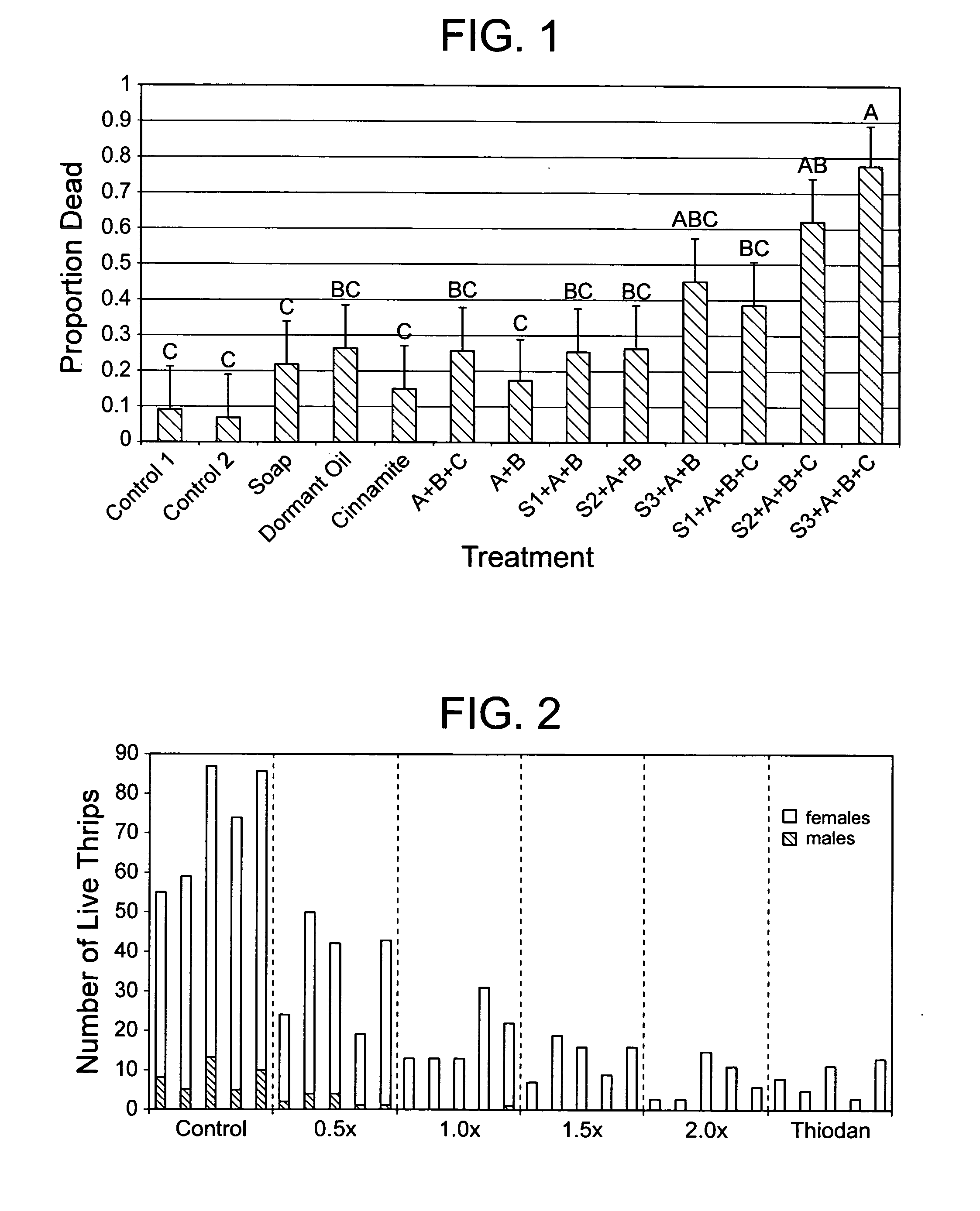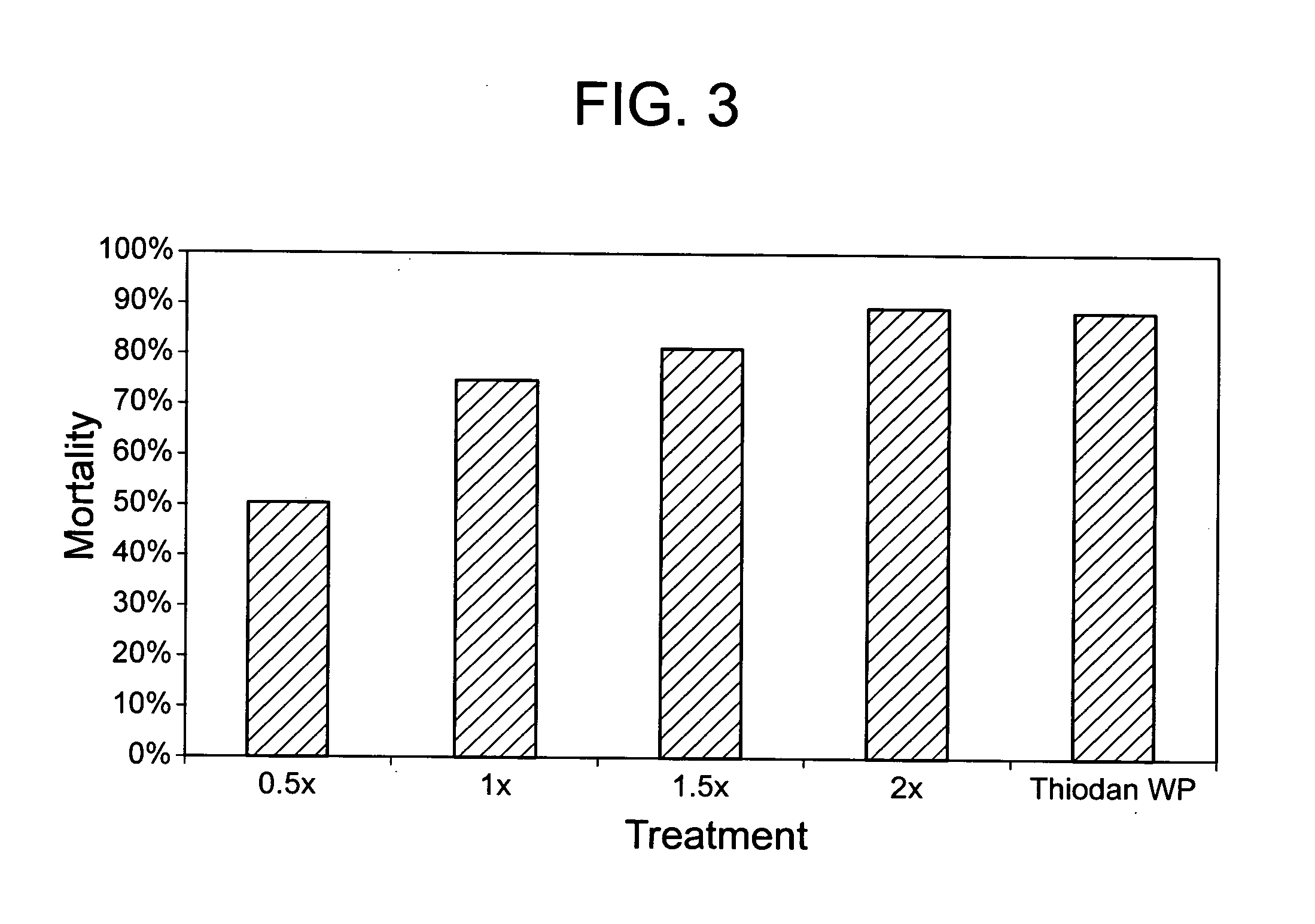Non-toxic insecticide
a non-toxic, insecticide technology, applied in the direction of anhydride/acid/halide active ingredients, biocide, plant/algae/fungi/lichens ingredients, etc., can solve the problems of insufficient lethal to the targeted insect, inability to meet the usual test criteria of ingredients, and inability to demonstrate real efficacy of non-poisonous insecticides. to achieve the effect of reducing the risk of insect bi
- Summary
- Abstract
- Description
- Claims
- Application Information
AI Technical Summary
Benefits of technology
Problems solved by technology
Method used
Image
Examples
example 1
[0040
In Vitro Tests
[0041]In an experiment, combinations of dormant oil, cinnamon oil, and clove oil, with and without an emulsifier, were tested against adult western flower thrips. The cinnamon oil comprised 83% cinnamaldehyde, 10.84% eugenol with other minor components including 2% trans-caryophyllene and 1.03% (−)-caryophyllene oxide. The following combinations were tested:
CombinationComponentsA + B0.6% dormant oil0.2% cinnamon oilA + B + C0.6% dormant oil0.2% cinnamon oil0.1% clove oilS1 + A + B0.6% dormant oil0.2% cinnamon oil 0.2% PSFAS2 + A + B0.6% dormant oil0.2% cinnamon oil0.725% PSFAS3 + A + B0.6% dormant oil0.2% cinnamon oil 1.25% PSFAS1 + A + B + C0.6% dormant oil0.2% cinnamon oil0.1% clove oil 0.2% PSFAS2 + A + B + C0.6% dormant oil0.2% cinnamon oil0.1% clove oil0.725% PSFAS3 + A + B + C0.6% dormant oil0.2% cinnamon oil0.1% clove oil 1.25% PSFAwhere S1 = 0.2% PSFA, S2 = 0.725% PSFA, S3 = 1.25% PSFA, and A = 0.6% dormant oil, B = 0.2% cinnamon oil (83% cinnamaldehyde an...
example 2
[0044
Greenhouse Trials
[0045]100 female and 20 male western flower thrips from a laboratory culture were placed on poinsettia plants in 10 cm pots. Each plant was enclosed in a nylon sleeve. The plants were left for 24 hours in a greenhouse before treatment with a test composition ARC1004, a registered insecticide Thiodan® WP (Hoechst Schering AgrEvo GmbH) as an industry standard, and water. Five plants each were assigned to a water control, the industry standard, and ARC1004 at 0.5×, 1.0×, 1.5× and 2.0× rates. ARC1004 had the following composition:
RateIngredient0.5x1.0x1.5x2.0xmineral oil0.60%1.20%1.80%2.40%clove oil0.05%0.10%0.15%0.20%cinnamon oil0.10%0.20%0.30%0.40%PSFA0.13%0.25%0.38%0.50%
[0046]For treatment, the plants were removed one at a time from their sleeves, and the products were applied by using a hand-operated sprayer until runoff from all sides. Any thrips which escaped from this process were counted and destroyed. The plant was then re-sleeved and placed on a greenhous...
example 3
[0048
[0049]Several formulations were prepared by mixing together the following components in the proportions indicated:[0050](a) 0.1-2.0% of an emulsifier;[0051](b) 0.1-1.8% horticultural oil;[0052](c) 0.1-1.2% cinnamaldehyde; and[0053](d) 0.1-1.2% eugenol.
[0054]The emulsifier comprised potassium salts of fatty acids. The horticultural oil comprised dormant oil in one formulation, and mineral oil in another formulation.
PUM
| Property | Measurement | Unit |
|---|---|---|
| RH | aaaaa | aaaaa |
| composition | aaaaa | aaaaa |
| concentrations | aaaaa | aaaaa |
Abstract
Description
Claims
Application Information
 Login to View More
Login to View More - R&D
- Intellectual Property
- Life Sciences
- Materials
- Tech Scout
- Unparalleled Data Quality
- Higher Quality Content
- 60% Fewer Hallucinations
Browse by: Latest US Patents, China's latest patents, Technical Efficacy Thesaurus, Application Domain, Technology Topic, Popular Technical Reports.
© 2025 PatSnap. All rights reserved.Legal|Privacy policy|Modern Slavery Act Transparency Statement|Sitemap|About US| Contact US: help@patsnap.com


